Huddersfield Art Gallery collections
We have an extensive and stunning collection of paintings, drawings and sculptures by internationally renowned artists such as L.S. Lowry, Francis Bacon and Henry Moore - here are some suggestions but you can find your own highlight!
Huddersfield Art Gallery Top 10 collection highlights
Francis Bacon is now recognised as one of the most influential painters of the second half of the twentieth century, although when Figure Study II was first exhibited in London in 1946 he was largely unknown outside a small group of fellow artists and critics. The work was purchased by the Contemporary Art Society from the exhibition at the Lefevre Gallery but it was not until 1952 that Ronald Gelsthorpe, the curator of Batley Art Gallery, accepted it on behalf of Batley making it the first work by Bacon to enter a public collection outside London.
Figure Study II is one of a series of paintings from the 1940s that feature a range of visual elements-coats, umbrellas, plants and flowers, and in this case a screaming figure-set in ambiguous interiors with an orange background. They represent the first group of works that Bacon was confident about exhibiting, having destroyed a number of earlier works from the 1930s. Due to the notoriety of 'Three Studies for Figures at the Base of a Crucifixion', 1944, acquired by Tate in 1953, many of these works were assumed to have religious subjects, something which the vehemently atheist artist later denied. The generally accepted apocalyptic nature of the subjects can be seen as a response to the impact of the recent world war and contemporary feelings of despair and isolation.
You can explore his work and process on his website.
Presented to Batley Art Gallery by the Contemporary Art Society in 1952.

L S Lowry (1887-1976) grew up in Rusholme in Manchester. When he moved with his parents to Salford in 1909, he became fascinated by the industrial surroundings and felt compelled to paint the terraced houses, factories, smoking chimneys and crowds of people streaming to and from the mills. He always carried a sketch book and pencils to record the scenes and characters he encountered on his travels:
"For a great many years, when I was very active, I used to visit all the industrial towns and stop a couple of nights in each. Huddersfield in particular I'd go back to. And I always gravitated to the poorer areas. It wasn't that I felt sorry for those people; they were just as happy as anyone else, and certainly as happy as I was".
The view of the Chapel Hill looking towards Lockwood was commissioned by Huddersfield Borough Council in 1965, and is a classic industrial landscape with all the ingredients that made Lowry the best known artist in the country and one of the best loved.
There is also a view from the Staffordshire town of Burton upon Trent. Lowry had a long career and apart from his industrial scenes he produced landscapes, seascapes, portraits and figure studies, but it is for his visions of gritty urban reality that he is most famous.
You can view some more of LS Lowry's artwork on The Lowry website.
Level Crossing, 1961
L.S Lowry (1887-1967)
Oil on canvas.
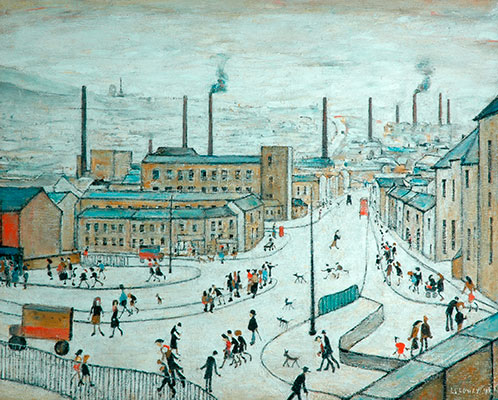
Moore is one of the most important sculptors of the 20th century; his works feature in public places around the world. Born in Castleford, Yorkshire, the son of a coal miner, Moore studied at Leeds School of Art and the Royal College of Art where he later taught.
He is best known for monumental sculptures in marble, wood and bronze that explore the human form. Of this sculpture, Moore stated:
"The idea for 'The Warrior' came to me at the end of 1952 or very early in 1953. It was evolved from a pebble I found on the seashore in the summer of 1952, and which reminded me of the stump of a leg, amputated at the hip. Just as Leonardo says somewhere in his notebooks that a painter can find a battle scene in the lichen marks on a wall, so this gave me the start of 'The Warrior' idea".
Whilst Henry Moore is one of the best loved and most respected British artists of the 20th century, the purchase in 1958 of this sculpture by Huddersfield Art Gallery provoked great controversy. There was a great deal of debate in the local press, with one letter to the Huddersfield Examiner stating:
"When this ugly distorted depiction of the human body is installed in the Art Gallery, sited so that the monstrous form may be viewed from all angles may I suggest that the plaque be removed and a new one bearing the words 'Huddersfield Rate-payer' be attached?"
On 5th November 1958, the purchase of the work was discussed and voted on by the Town Council. The debate for and against lasted an hour and a quarter. By a majority of 29 to15, the purchase was finally ratified and the work was acquired at a heavily discounted price. The artwork has gone on to become one of the most loved works in the gallery's collection.
You can view some more of Henry Moores work and his famous Falling Warrior on the Henry Moore website.
Henry Moore (1898-1986)
Falling Warrior, 1956/57
Bronze

The Victorian artist John Atkinson Grimshaw was a Leeds born painter of landscapes, town views and dockyards, especially at sunset or by moonlight.
Atkinson Grimshaw first began painting while working as a clerk for the Great Northern Railway. Towns and docks featured heavily in his highly atmospheric paintings. He painted famous dockyard scenes including Glasgow Docks, Liverpool Docks as well as a number of paintings focussed on Leeds, Scarborough, Whitby and London.
Atkinson Grimshaw's artistic style and subject matter changed very little during his painting career; he strove constantly to perfect his own individual vision. Although Atkinson Grimshaw's moonlit towns scenes remain his most popular works, he also painted interiors and fairy prints.
Silver Moonlight, 1886
Atkinson Grimshaw (1836-1895)
Oil on canvas
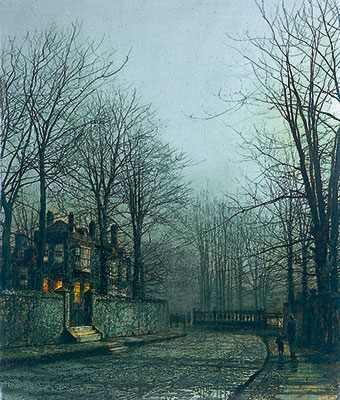
John Martin's spectacular paintings, featuring panoramic scenes of battles, biblical catastrophes and the vastness of nature, moved and astonished viewers in his own day.
One of his paintings, 'Joshua commanding the sun to stand still upon Gibeon, 1848', is a second version of an artwork that Martin exhibited to great acclaim at the Royal Academy in 1816. The subject is taken from the Old Testament Book of Joshua. Joshua was the leader of the Israelite tribes in their conquest of the Land of Canaan, and is here shown leading his army against the Amorites, who had laid siege to the Canaanite city of Gibeon. A terrible hailstorm has already wreaked havoc upon the Amorite army, but Joshua (prominent on the rock in the foreground) calls upon God to "make the sun stand still" in the sky, extending daylight so that his army can complete their destruction of the enemy.
Another version was painted for Charles Scarisbrick, a wealthy landowner and businessmen, and hung in his lavish Gothic revival mansion designed by Augustus Pugin. The painting later passed into the ownership of Charles Brooke Crawshaw. Originally from Huddersfield, the Crawshaws were colliery owners. Charles Brooke Crawshaw lived in Dewsbury and in 1929 he bequeathed his collection of paintings to Dewsbury Corporation to form the nucleus of an art gallery for the town.
Joshua commanding the sun to stand still upon Gibeon, 1848
John Martin (1789-1854)
Oil on canvas.

Philip Wilson Steer was born at Birkenhead in 1860, the son of Philip Steer, a painter of portraits and teacher of painting. Along with his friend Walter Sickert, he was to become a leading figure in British Impressionism.
Quiet Occupation
Philip Wilson Steer: 1960-1942
Oil on canvas
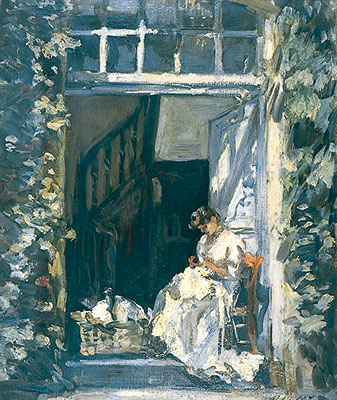
You can also view some more of his artwork on the ArtUK website:
Stanley Spencer was one of the most original British painters of his generation. His paintings combined the realism of everyday life with dreamlike visions drawn from his imagination.
Spencer spent most of his life in the sleepy village of Cookham, Hampshire, which he referred to as "a village in Heaven". The area was a major source of inspiration and even provided the setting for his many Biblical paintings such as Christ Carrying the Cross. He was a familiar sight in the village, pushing a battered black pram in which he carried his canvas and easel.
Garden at Cookham Rise, 1946
Stanley Spencer: 1891-1959
Oil on canvas
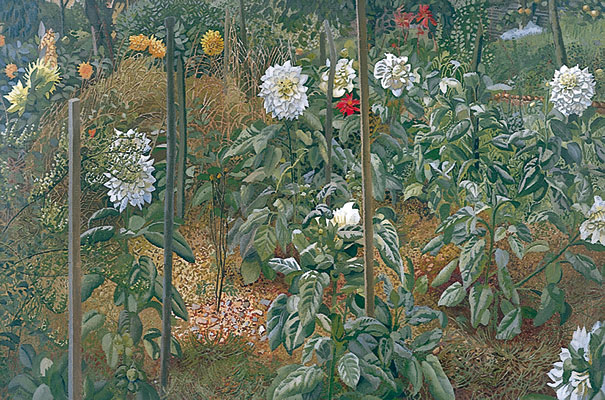
Lucien Pissarro was the eldest son of Camille Pissarro, a leading figure in the Impressionist movement and one time pupil of Corot.
In the 1880s, along with his father, Georges Seurat, and Paul Signac, Lucien Pissarro was involved with the conception of Pointillism (a technique of painting in which small, distinct dots of pure colour are applied in patterns to form an image). He moved to England in 1890, bringing with him first-hand knowledge of new artistic developments in France. In 1916 he became a British citizen and was one of the founders of the Camden Town Group of artists.
Milton East Knoyle, 1916
Lucien Pissaro (1863-1944)
Oil on canvas.
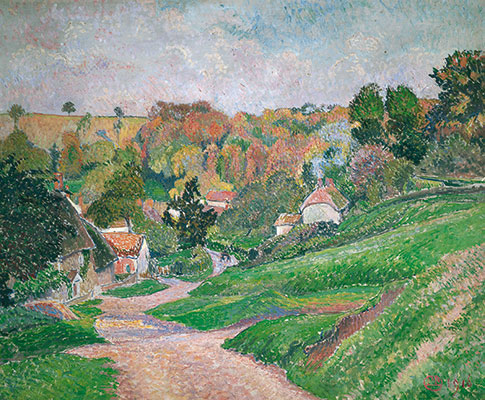
Born in New York of Russian and Polish parents, Epstein studied in Paris before settling in London in 1907. As a student, through visits to the Louvre, he developed a fascination with ancient and primitive sculpture.
Sir Jacob Epstein wrote a letter to Huddersfield Art Gallery upon the occasion of the acquisition of his sculpture: "I am very pleased you are having my portrait of Prof Einstein which I consider perhaps my finest portrait, and is certainly the portrait of a great man."
Epstein also said of Einstein: "He resembled the ageing Rembrandt". And we can certainly recognise the likeable mixture of humility and deep intelligence, the somewhat dishevelled charisma. "If you are out to describe the truth, leave elegance to the tailor", Albert Einstein is reputed to have said referring to his own notorious scruffiness. Epstein has also captured this in a parallel of style: rough and unpolished as it may be, the spectator viewing this powerful bust of Einstein is left in not doubt that the subject has been treated in a truthful way.
Epstein is said to have regretted not being able to work longer on the sculpture before his subject left England; but it is difficult to imagine what more he could have done. Criticised in his lifetime for the unfinished look of his portrait bronzes, what he said in his defence applies very much to his work: "It is the rough surface which gives both character and likeness to the face." Such vigorous handling, reminiscent of Rodin, does indeed give an immediate sense of character and psychological truth.
Einstein was said to be affably informal. Indeed, in 1933 having fled Hitler's Germany, his work condemned as 'Jewish Physics', and in a beach hut containing a piano, near Cromer on the Norfolk coast, Einstein smoked his pipe and chatted as Epstein modelled his head in clay: the result being that genius has here been humanised.
Professor Albert Einstein, 1933
Jacob Epstein (1880-1959)
Bronze
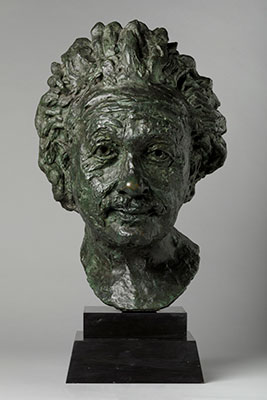
The Camden Town Group was a group of English Post-Impressionist artists active 1911-1913 painting pictures of modern everyday life. They gathered at the studio of Walter Sickert in the Camden Town area of London.
Members included Walter Sickert, Harold Gilman, Spencer Gore, Lucien Pissarro, Robert Bevan, Augustus John and Duncan Grant. Paintings by each of these artists are part of the Kirklees collections at Huddersfield Art Gallery. Influences include Van Gogh and Gauguin. The Group's portrayal of much of London before and during World War 1 is historically interesting and artistically important.
Bevan, a founder member of the Camden Town Group, showed a partiality for market scenes and horses - this picture records horse sales at a London market.
Bevan and most of the Group had lived in Paris when the art of Cezanne, Van Gogh, Gauguin and Seurat was well established. Bevan was influenced by Gauguin, bringing to his very English images Gauguin's feelings for simplicity and density.
Harold Gilman joined the Group in 1911. His concentration on domestic interiors, painted with subtle, quiet realism was a departure from the conventions of English painting, as was his use of bright, pure colour. He was an observer of London eating-houses, furnished rooms, landladies and parlours of the mid Edwardian years: these subjects he made his own. In 1917 he was commissioned by the Canadian War Memorials Fund to paint Halifax Harbour. He died soon after completion, in the Spanish influenza epidemic of 1919.
Tea in the Bedsitter, 1916
Harold Gilman (1876-1919)
Oil on canvas.
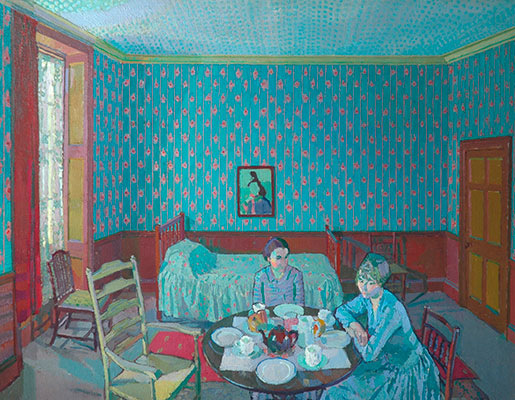
Was this information useful?
We'd like your feedback to improve the Kirklees Council website and the information we provide.




